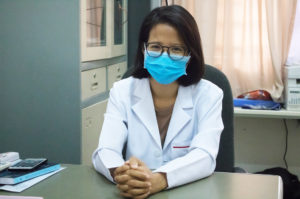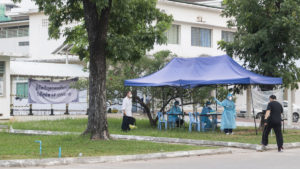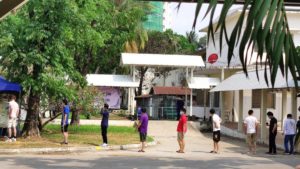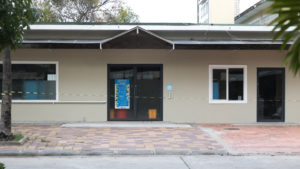Interview: Covid-19 Treatment Process in Cambodia
Covid-19
cases have been continuously discovered in Cambodia since January of
this year. Despite the very public exposure of these cases, most people
do not know what goes into treating a patient afflicted with Covid-19 in
Cambodia.

Focus recently conducted an
interview with Dr. Chhorn Sotheary, deputy in the pneumology department
at Khmer-Soviet Friendship Hospital, a center for Covid-19 testing. As
one of the frontline team members in charge of Covid-19, Focus spoke
with Dr. Sotheary in order to better understand the Covid-19 treatment
process in Cambodia.
How does the hospital divide up employees into teams?
We divide employees into four big
teams, including two teams for the emergency department, a team for the
infectious disease department and a team for the pneumology department
and each team contains, in total, 12 employees. They have three shifts
per day in order to look after the patients, meaning that each small
group within the big teams has to work eight hours a day. Each team is
comprised of:
- One major doctor (team leader)
- Four doctors
- Four employees
- Two nurses
- One cleaner
What is each team member’s responsibility?
If a patient is not in need of
anything at the moment, doctors can watch them through a camera.
However, if patients show severe symptoms, they must put on personal
protective equipment (PPE) before checking the patients. As well,
nurses’ responsibilities are to measure patients’ blood pressure and
heart rhythm, examine oxygen tanks, and distribute medicine. Cleaning
teams take turns cleaning the exterior and interior space of patients’
rooms. We generally have two cleaning shifts per day, but sometimes only
one.
Before dispatching frontline workers, what types of training have they received?
Before we permitted the four teams to
treat patients, a training program was provided by specialists. Three
important points are:
- They have to be aware of patient room layout, clearly understanding the entrance and exit. Also, they need to be equipped with PPE before entering and know how to disinfect after exiting. They were informed about equipment inside patients’ rooms, which includes the cleaning system and ultraviolet system, and how the equipment can be utilized.
- They were trained carefully on the steps of putting on and taking off PPE as it can be complicated. They had to practice until perfection, otherwise we would not permit them to enter.
- We trained them on how to conduct swab tests, which are performed regularly on Covid-19 patients.
Are there things teams are not permitted to do?
Once they enter the patients’ room,
they are not allowed to exit, and to take care of other patients. All in
all, they are not permitted to move beyond a set line. So, they have to
work with a small team for external needs.
If they require something,
communication via the internet is advised to their team. The doctor team
will inform the treatment team about patients’ demands while the nurse
team will discuss patients’ health conditions and seek treatment
solutions.
Every type of communication is
through the internet as every room is equipped with cameras, which are
not intended to violate the privacy of patients, but to watch closely on
their conditions because the employees cannot have PPE on for eight
hours. PPE is used in case of necessity, as it is heavy and
suffocating.
After finishing the check up
(delivering medicine, measuring blood pressure and temperature, and
checking the oxygen system), the team can take the PPE off and stand by
in a nearby room.
Inside patients’ rooms are a
microphone and mobile phone for patients to call standby doctors in case
of emergency, and in spite of no contact, patients can be seen through
cameras.
Did employees have to quarantine?
Presently, there is a final team
quarantining. In the hospital, we have clear strategies and protocols;
if anyone in the team shows any symptoms, they will receive a swab
test.
After their 2-week term of duty, even
if they show no symptoms, a swab test for the 12 members of the team is
necessary. If someone among them becomes infected, they will receive
treatments as other patients. Even if they test negative, they are not
immediately discharged and are placed in a 14-day-quarantine in one of
the hospital’s buildings.
Once the time is complete, they will
receive another swab test. If the test is negative, they are then
discharged. The process guarantees high safety as tests had been
conducted twice.
What are the differences in entering the hospital for general medical needs and Covid-19 patients?
The hospital has out-patient and in-patient departments; amongst these, there is a separate department for general illness.
We provide information on the
hospital’s page for people who want to come for Covid-19 related
consultation, and if they are not aware of the steps, there is a
security guard at the front gate offering information based on the
purpose of the visit.
If anyone visits for Covid-19
testing, they have to enter through a special route leading them to the
consulting room. In the hospital there is a specific team working on
logistics for Covid-19 patients and people who might have the virus.
After the consultation, if the doctor thinks that they may be infected, a
sample will be drawn and delivered to the Pasteur Institute of
Cambodia. If the result is positive, they will be contacted for
treatment by the hospital.

Are people invited to come for testing?
People can ask for testing as the
Ministry of Health made an announcement on locations for Covid-19 tests.
They can also dial 115, and if the 115 team advises for them to be
tested, we will provide them a test.
Are many people currently asking for Covid-19 tests?
It remains regular. Presently, the
number of tests conducted is decreasing, about 10 tests per day,
compared to the outbreak period, approximately 100 tests per day. People
who received tests were Chinese, French, Vietnamese, and others, and it
has been a language challenge.
How many tests have been conducted so far?
Up until present, there have been
4,000 to 5,000 people tested, including children. A child with a foreign
nationality tested positive and was transported to National Pediatric
Hospital.
What is the process of the Covid-19 test?
People who are suspected of being
infected will receive a test. The sample is collected from droplets in
the nose and throat by a doctor with PPE and immediately will be
delivered to the Pasteur Institute of Cambodia, as the sample cannot be
stored for long.
Generally, within 24 hours we will
obtain the results, compared to about 48 hours during the outbreak
period. The samples are sent two times per day as the hospital provides
morning and afternoon consulting services. Doctors start the
consultation at 8:00 am and in case of suspicion, visitors will get
tested.

What are the hospital’s measures in case of positive results?
If a person is positive, everyone who
has been in close contact with the person will be investigated, and we
request they get tested. We have assistance from the Health Ministry’s
rapid response team (RRT) and vice versa. If someone’s result is
positive, his/her co-workers and family members will be all tested. The
hospital will inform the Ministry and then RRT will begin the
operations.
Will people be isolated after they get tested?
It depends. We do not have adequate
space for everyone. After the consultation, if they have a high chance
of having contracted the virus, we will run a test and advise them to
continue wearing masks and self isolate until the release of the
results. For a case of someone showing symptoms, the hospital has five
reserved rooms where they can be placed and provide meals for them as
they should not be in contact with anyone. If they feel better later,
they will be transferred to the pneumology department, which also has
five spare rooms. The hospital also has three spare rooms in the
Emergency Department.
How does the hospital contact patients whose results are positive?
People have to fill out a medical
form before getting tested, which includes symptoms, nationality, and
contact number. In the case of non-residents, they might not have a
contact number, so we ask for an address of a hotel or an apartment.
Frankly, it varies from case to case as some might come by personal
motorbike or car, which will be sprayed with disinfectants. The hospital
discourages them from taking a tuk tuk; we will arrange an ambulance to
ensure safety on the journey.
How does the hospital contact people whose results are negative?
Despite negative test results, we ask
them to self isolate. However, if people who have tested negative show
high fever and were recently in China, we definitely make a next
appointment after a five-day self-isolation. In case they do not come,
the hospital will contact them. We have this protocol for those who were
at high risk and some people do not return, in particular foreigners.
What is the treatment process?
As soon as the test is positive,
patients will be transferred to a Covid-19 room, which is renovated for
ventilation and space. The Covid-19 rooms are located a safe distance
from other rooms.
Presently, there are no certain
treatments or medications; however, the treatments focus on supporting
care based on patients’ symptoms, such as some nutrients and vitamins,
to boost their immune system.
We also collaborate with
psychiatrists as the patients normally have health conditions and have
difficulty falling asleep, as well as being stressed. The Covid-19 team
reports patients’ mental health symptoms through its network in the
hospital and the psychiatrist team will prescribe medication.
The Covid-19 teams can only:
- provide nutrients
- prescribe vitamins to assist immunity
- provide treatments based on patients’ symptoms
- give treatments based on patients’ condition.
If they need oxygen, we will attach
them to an oxygen tube, and if they presently require a ventilator, we
will provide them a ventilator. However, none of the Covid-19 patients
were in critical enough condition that they needed a ventilator, but
many patients have required oxygen support.
Could you describe mild and critical conditions ?
Some patients have shown no severe
symptoms; however, the virus stays in the body, making them exhausted
and requiring them to be hospitalized to prevent the spread. We
experienced a critical condition in a non-Cambodian elder patient who is
a regular smoker, causing absolutely unhealthy lungs. Covid-19 worsened
his health condition. In his case, we provided treatments on his
existing illness, nutrients, and oxygen, and fortunately, he
recovered.
How many Covid-19 rooms are available in the Khmer-Soviet Friendship hospital ?
We have one spacious room that can
host 10 people and each bed is placed 1.5 meters apart. The hospital
does not allow site visitors, but family members can contact by phone or
internet available in the room as we permit laptops and mobile phones
in the room. Once they are discharged from the hospital, we will
disinfect their electronic devices.

What are the protocols for distressed Covid-19 patients?
Many patients are normally very
stressed with the situation. If patients show insomnia symptoms,
Covid-19 doctors will report through a mobile phone and then our team
will directly inform the psychology department. Three phones are
available in the room for communication. For critical cases, the
hospital’s psychiatrists will talk to the patients via a mobile phone
and in some other cases, doctors in charge will deliver medicines to the
patients.
How many times per day must doctors visit patients?
Our main visits are in the morning
and afternoon and we have three teams shifting to examine patients’
condition such as breathing rhythm, oxygen level, blood pressure,
temperature, and consciousness. We try to fulfill patients’ needs, and
theoretically we should visit them three times; however, if it is very
late or patients do not need anything, we do not disturb them. Overall,
we must at least pay them a visit two times per day and report to team
leaders. All the equipment from the outside must be disinfected in order
to avoid close contact infection.
What types of medication required to treat Covid-19?
We are not certain about the one
specific type of medication, as there is yet no cure. We do not
prescribe harmful medication and I believe the majority of people have
learned that malaria and HIV medications are not the 100% claimed
treatment for Covid-19, but are simply rumours from China and some
European countries. Patients become better with the medications, but,
there are heavy side effects we have to be aware of.
Taking the medications without
prescription also triggers high risks. For instance, malaria medication
is prescribed based on patients’ heart conditions. Since the hospital
equips the rooms with electrocardiography (ECG) machines, if patients
show any side effects, we are able to treat them on time. If necessary,
we do not prescribe more medications. We advise everyone not to purchase
medication without prescription though they might have heard from
social media or other sources because it can be catastrophic to life.
How do doctors know when patients are fully recovered?
The hospital will scan patients’
lungs according to protocol and examine breathing rhythm as well as
blood pressure as soon as they arrive. However, swab test is currently
the only conclusive method for Covid-19.
According to the Ministry of Health
in Cambodia, a patient is completely received as long as there are no
symptoms and negative swab test results two times within 48 hours. If a
patient meets the two criteria, s/he will be discharged from the
hospital under a condition of further 14-day-self-quarantine. On the
13th day, the patient must visit the hospital for a final swab test. If
the result is negative, they will be permitted to work.
Has the hospital lacked any medical equipment?
PPE is the most essential equipment,
which includes a double-layer shirt, a thick pair of shoes, socks,
double-layer gloves, goggles, a face shield, and an N95 mask. Presently,
we have adequate equipment; however, we minimize the use as some teams
require PPE while the other teams do not.
Has the hospital fully prepared for a possible second wave?
We are always ready because the teams
remain assembled. We have prepared equipment and medical teams for the
possible second wave, yet I hope everyone will combat the spread of the
virus by implementing protection measures in order to avoid it.
Do patients have to pay for Covid-19 treatment?
The Health Ministry has announced
free-of-charge service to Covid-19 patients and also encouraged
frontliners to wholeheartedly take care of the patients.
It was reported that some medical employees are not familiar with collecting samples. Does the hospital have a comment on this issue?
I have seen the comment. Each medical
employee has a different technique; two people learn how to give an
injection, and of course they have different methods. It depends on
patients, as some patients are sensitive with their noses and on
patients’ health condition because they might have nose problems such as
deviated septum and nasal cavity tissue growth.
Overall, both an employee’s technique
and a patient’s nose condition are the causes. Every medical employee
has received proper training before being sent to the hospital.
Another cause is injection difficulty
when our employees are in PPE, as their touching sense cannot be
applied through double-layer thick gloves, resulting in difficulties to
feel patients’ veins.

No comments:
Post a Comment